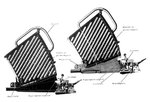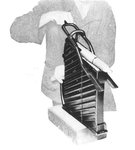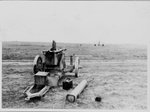Navigation
Install the app
How to install the app on iOS
Follow along with the video below to see how to install our site as a web app on your home screen.
Note: This feature may not be available in some browsers.
More options
You are using an out of date browser. It may not display this or other websites correctly.
You should upgrade or use an alternative browser.
You should upgrade or use an alternative browser.
Luftwaffe Cannons and Machineguns topic.
- Thread starter CharlesBronson
- Start date
Ad: This forum contains affiliate links to products on Amazon and eBay. More information in Terms and rules
More options
Who Replied?- Thread starter
- #262
CharlesBronson
Senior Master Sergeant
Now is better, thank you very mucho.
Hello,
I don't suppose the experts here have ever come across any photos of underwing field modifications using the MG-FF? I am specifically interested in the 2 X MG-FF optional armament for the Hs123 that I have seen printed in numerous places but I have never seen a picture or drawing of. Was this ever used operationally or even just on a test basis?
Cheers and many thanks for any responses,
Fafnir_6
I don't suppose the experts here have ever come across any photos of underwing field modifications using the MG-FF? I am specifically interested in the 2 X MG-FF optional armament for the Hs123 that I have seen printed in numerous places but I have never seen a picture or drawing of. Was this ever used operationally or even just on a test basis?
Cheers and many thanks for any responses,
Fafnir_6
Civettone
Tech Sergeant
Didn't the Ju 87 have a similar one??
Kris
Kris
Tzaw1
Airman 1st Class
Hello,
I am specifically interested in the 2 X MG-FF optional armament for the Hs123 that I have seen printed in numerous places but I have never seen a picture or drawing of.
Only this:
Henschel-123 TB&I - AviaSkins.Forums
Post #12
Hmmm Thanks for the link
Thanks,
Fafnir_6
- Thread starter
- #268
CharlesBronson
Senior Master Sergeant
The only containers I had seen on stukas was for MG 81zs, never for cannons.
Last edited:
they must have carried a couple dozen of those saddle drums...
Indeed, I have a nice cross section pictures of Do 17Z in a book called "Finnish Air Force History 2: Dornier Do 17Z Junkers Ju 88A-4".
There seems to be 40 of these 75 round magazines for the 6 MG 15s in the cockpit, 6 on the guns and 34 in reserve. That makes a total of 3000 rounds, 500 per gun. Still, not too much.
- Thread starter
- #270
CharlesBronson
Senior Master Sergeant
Rheinmetall MK 101 30mm aditions and corrections:
- The hartkern panzergranate was first tested in Rechlins ground firing range in 1940.
- Singles stack box magazines used in the Me-110C were 6 shot capacity and not 10 shot.
- The gun has a quick change barrel despite its size.
- Mk 101 was in fact more lighter that the usual number given in allied postwar publications.
- Is stimated that more than 300 kg of raw material were needed to complete a MK 101 including 200 kg of high quality steel. 5141 different milling and machning operation wre involved making the Mk 101 a very expensive weapon.
Correct figures
Weight empty: 139 kg
Weight with full 6 round magazine: 153 kg.
Weight with full 30 round drum: 185 kg.
Barrel lenght (with muzzle brake): 1350mm
Overall lenght: 2592 mm
Weight of the barrel: 43 kg.
Aditional images: 6 round magazine and ground aiming/testing.
- The hartkern panzergranate was first tested in Rechlins ground firing range in 1940.
- Singles stack box magazines used in the Me-110C were 6 shot capacity and not 10 shot.
- The gun has a quick change barrel despite its size.
- Mk 101 was in fact more lighter that the usual number given in allied postwar publications.
- Is stimated that more than 300 kg of raw material were needed to complete a MK 101 including 200 kg of high quality steel. 5141 different milling and machning operation wre involved making the Mk 101 a very expensive weapon.
Correct figures
Weight empty: 139 kg
Weight with full 6 round magazine: 153 kg.
Weight with full 30 round drum: 185 kg.
Barrel lenght (with muzzle brake): 1350mm
Overall lenght: 2592 mm
Weight of the barrel: 43 kg.
Aditional images: 6 round magazine and ground aiming/testing.
Attachments
Last edited:
Excellent stuff, as usual.
There has been recently discussion about incorrect weapons modelling in a certain WW2 air war simulation game. The game has flyable Do 335 A-0 and V13 in it, and they both feature MG 151/20 as cowl guns. Is this correct? Some sources say that these were 15 mm MG 151/15s, because they matched MK 103 ballistics better than the 20 mm version. But, I haven't found ANY information whether a synchronized version of the 151/15 ever existed. Only 151/20E is mentioned (for example, in this thread), yet still the 15 mm is often mentioned as the cowl armament. If someone knows better, I'm all ears.
There has been recently discussion about incorrect weapons modelling in a certain WW2 air war simulation game. The game has flyable Do 335 A-0 and V13 in it, and they both feature MG 151/20 as cowl guns. Is this correct? Some sources say that these were 15 mm MG 151/15s, because they matched MK 103 ballistics better than the 20 mm version. But, I haven't found ANY information whether a synchronized version of the 151/15 ever existed. Only 151/20E is mentioned (for example, in this thread), yet still the 15 mm is often mentioned as the cowl armament. If someone knows better, I'm all ears.
I'm 99% sure that no 15 mm MG 151 was used in synchronised wing position in the Fw 190, only MG 151/20E. But still, I'm unsure about the Do 335, and then the only reason for such variant (it needed different ammo because of the synchronisation) would have been the matching ballistics of the guns. I really doubt that such a variant ever existed, and the 15 mm cowl guns on the 335 could just be a myth.
But hey, I could still be wrong... and therefore, if anyone has any photos/info about such weapon, it would be great to see!
But hey, I could still be wrong... and therefore, if anyone has any photos/info about such weapon, it would be great to see!
- Thread starter
- #274
CharlesBronson
Senior Master Sergeant
I have posted some photos of the MG151 15mm already, the synchro guns in the FW-190 were 20mm, never 15mm.
Crimea_River
Marshal
Anyone have any more pics/diagrams of the WB 151 gondolas for the Me-109G-4/R6 shown in post 54? I'm trying to verify what appears to be a large opening in the side, probably the ejector chute.
Hello All,
Does anyone here have information as to how much each complete round and link for each of these guns weighs? I am trying to collect data to determine the weight of the disposable ammunition load for typical installations.
Perhaps it is in the images posted already? I can tell that there is a lot of mention of projectile weight and some images indicated propellant weight as well.
Thanks.
- Ivan.
Does anyone here have information as to how much each complete round and link for each of these guns weighs? I am trying to collect data to determine the weight of the disposable ammunition load for typical installations.
Perhaps it is in the images posted already? I can tell that there is a lot of mention of projectile weight and some images indicated propellant weight as well.
Thanks.
- Ivan.
- Thread starter
- #277
CharlesBronson
Senior Master Sergeant
Your request is a repeated one, unfortunately so far I been unable to get a credible source for a complete cartrigde-belt weight.

razor1uk
Staff Sergeant
I assume it used some similar bullets/shells as the other 20mm Mauser or Rheinmetall weapons with its specific semi rimmed recessed steel cartridges.
Thanks for the cartidge pic link Shortround6 8)
Would it appear that there is some simliarity in the bullet/shell designs used with other German 20mm weapon systems, as used with/in the 20/138-B cartridge casings?
Flak30/38 Info Link, Although this one suggest 50 round drums were used even if no other obvious evidence, maybe a test? the 'mags' info might be mixed up with the MGFF 2cm methinks, unless by the Kriegsmarine perhaps?
I have noticed that some other European sites list the 2cm Flak38 as Rheinmetall Borsig only weapon, even though Mauser was given the job to improve it because they were busy with other weapon projects.
I ask because I am starting to go through GMAX tutorial projects, and would like to make a Flakvieling as a near future project for a 3D model for an AAA mouning for a well known ww2 game.
I do not claim to be the only person allowed to work on something like this now or in the futures, some mod competition/inspiration is undoubtedly good Please don't begrudge me because I might tinker or mod a little, I think we all mod something or 1 game in our computers/user accounts no?
Please don't begrudge me because I might tinker or mod a little, I think we all mod something or 1 game in our computers/user accounts no?
I was wondering if there is anything good info/pics with dimensions if possible, connected with the 'Mauser 2cm Flak 30/38' and the 'Vierling' mounting system? (Like the width between/across the central chassis between the weapon elevation hubs/mounts/rings, for instance)
Thanks for the cartidge pic link Shortround6 8)
Would it appear that there is some simliarity in the bullet/shell designs used with other German 20mm weapon systems, as used with/in the 20/138-B cartridge casings?
Flak30/38 Info Link, Although this one suggest 50 round drums were used even if no other obvious evidence, maybe a test? the 'mags' info might be mixed up with the MGFF 2cm methinks, unless by the Kriegsmarine perhaps?
I have noticed that some other European sites list the 2cm Flak38 as Rheinmetall Borsig only weapon, even though Mauser was given the job to improve it because they were busy with other weapon projects.
I ask because I am starting to go through GMAX tutorial projects, and would like to make a Flakvieling as a near future project for a 3D model for an AAA mouning for a well known ww2 game.
I do not claim to be the only person allowed to work on something like this now or in the futures, some mod competition/inspiration is undoubtedly good
I was wondering if there is anything good info/pics with dimensions if possible, connected with the 'Mauser 2cm Flak 30/38' and the 'Vierling' mounting system? (Like the width between/across the central chassis between the weapon elevation hubs/mounts/rings, for instance)
Last edited by a moderator:
Shortround6
Lieutenant General
Excellent stuff, as usual.
There has been recently discussion about incorrect weapons modelling in a certain WW2 air war simulation game. The game has flyable Do 335 A-0 and V13 in it, and they both feature MG 151/20 as cowl guns. Is this correct? Some sources say that these were 15 mm MG 151/15s, because they matched MK 103 ballistics better than the 20 mm version. But, I haven't found ANY information whether a synchronized version of the 151/15 ever existed. Only 151/20E is mentioned (for example, in this thread), yet still the 15 mm is often mentioned as the cowl armament. If someone knows better, I'm all ears.
The Ta-152C-3 was tooling up for mass production alongside the C-1, the MG-151/15 synchronised version was proposed for this but I'm unsure if it entered production, I don't think there was any demand for them until Do-335 and/or Ta-152C-3 airframes needed them on the production lines. Until that time it's arguable what production examples would be armed with. The 152C-1 had 151/20E in the cowl and wing roots with Mk108 in the hub, these are easy and available armaments to place into Do-335 if rushed into production. Given time, perhaps the synchronised version of the 151/15 would be ready for the 152C-3 and the Do-335 attack version (both would would initially go to zerstörer squadrons not jäger as this was listed for their role).
However these are proposed aircraft and that is its proposed armament, and the ballistics were a definite plus which may very well have contributed to its pairing with the Mk103 if this weapon is fitted to either 152C or Do335. It may also be the 151/15 had a small stockpile of tungsten rounds, and had very good armour piercing qualities in its own right (it was originally meant to be the main fighter armament as in Rechlin tests one was equivalent to a pair of MG-FF, but pilots preferred the heavier 20mm explosive rounds, so the 151 was rechambered for 20mm).
Theoretically if you can synchronise an MG-151 there's little difference between 15mm and 20mm. Bigger charge cartridges are harder to synchronise but there's not much difference between these. Whether the Mk103 can synchronise is another matter, consensus so far is no.
So the original proposal for the Ta-152C-3 to be armed with 3 Mk103 (2 synchronised) and 2 Mk151/15(E) was revised during 1944 and it was by the end of the year to be armed with 4 Mk151/15(E) and 1 Mk103M.
Anyway the only difference is electrically fired ammo. They were moving in that direction anyway because it was troublesome to stock two different sets of ammo for common gun types.
Last edited:
Users who are viewing this thread
Total: 1 (members: 0, guests: 1)





